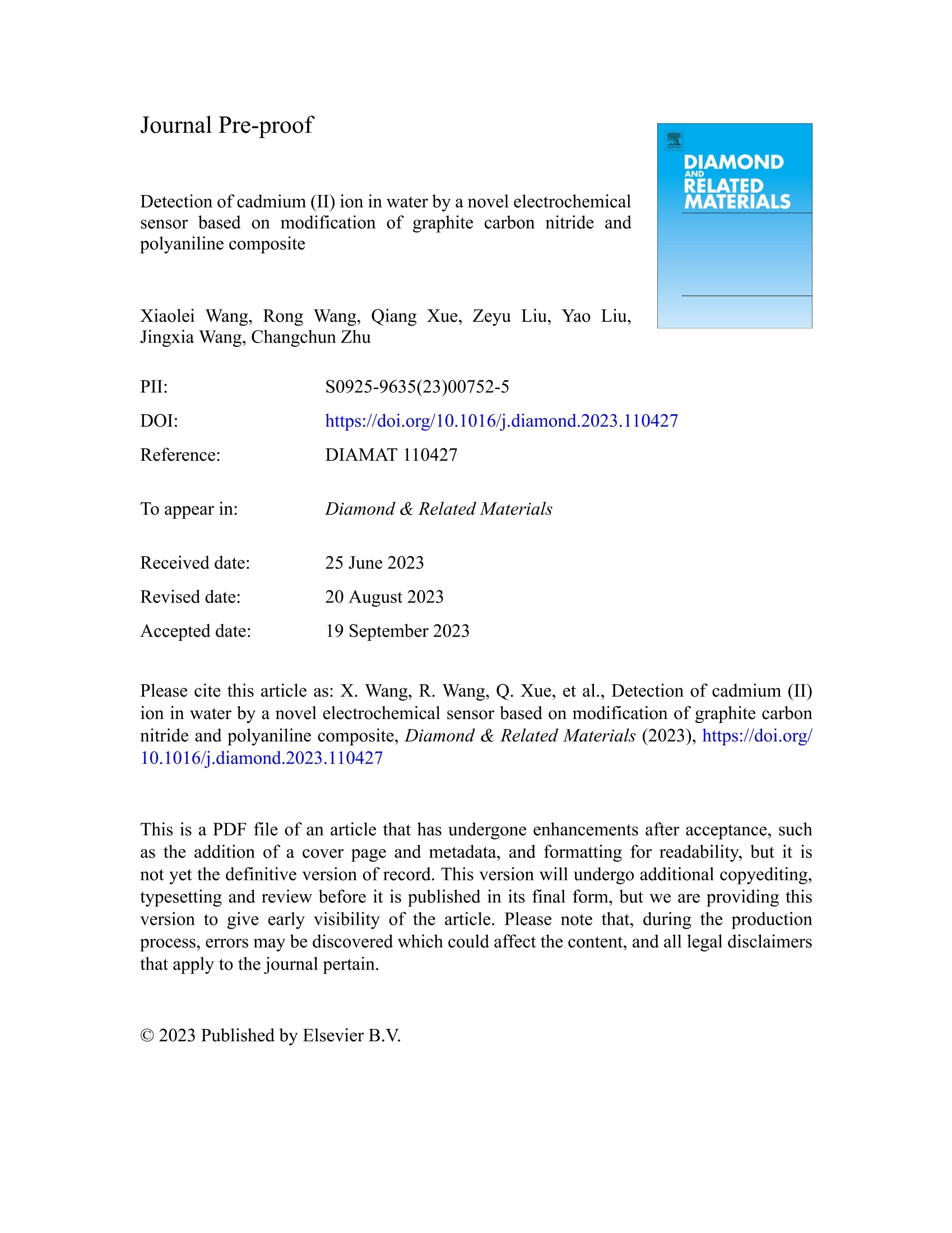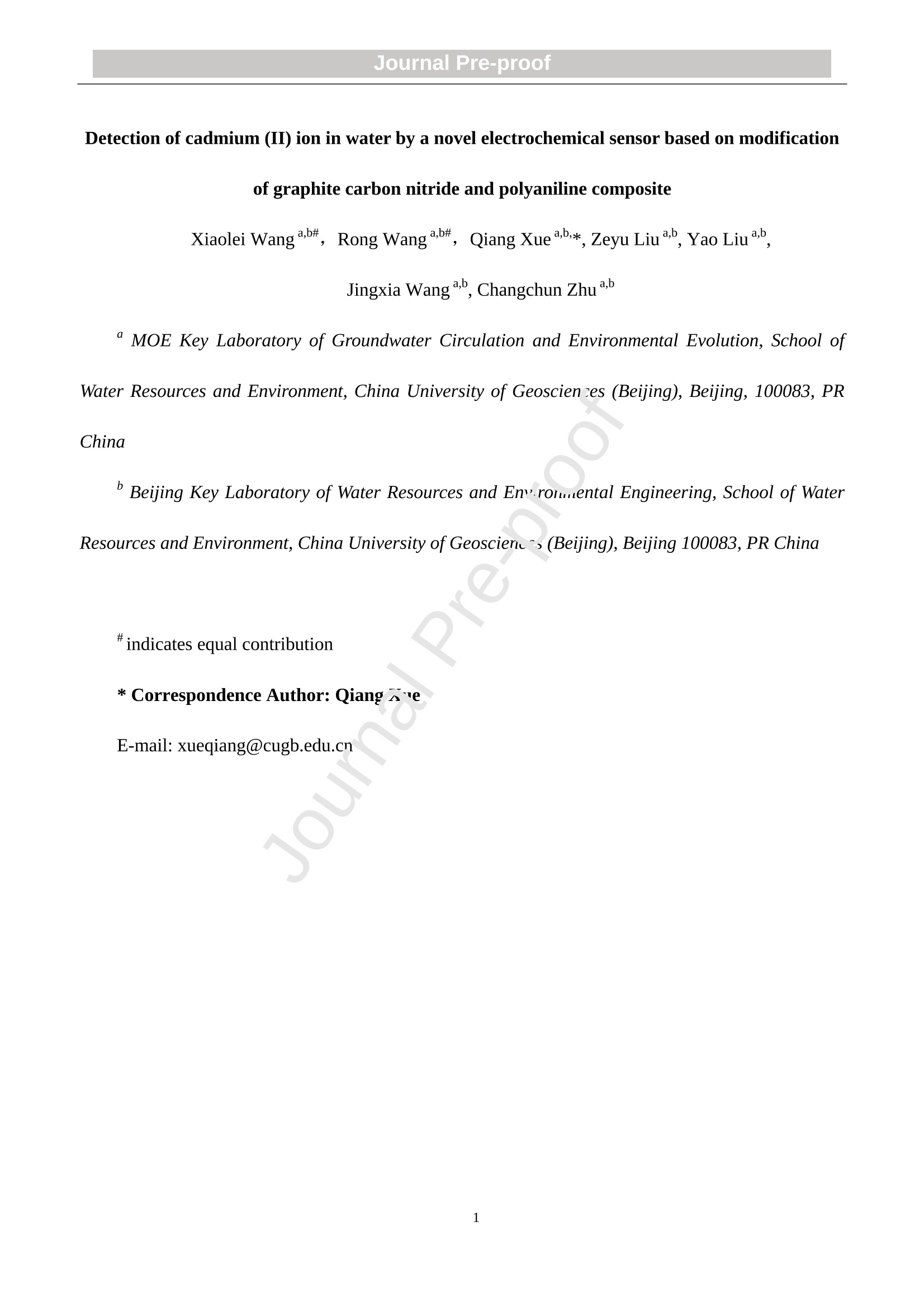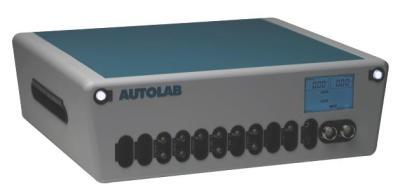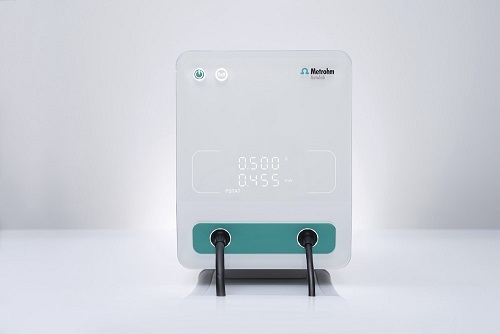【EmStat3Blue电化学应用】基于氮化石墨和聚苯胺复合材料改性的新型电化学传感器,检测水中的镉(II)离子
检测样品 环境水(除海水)
检测项目 (类)金属及其化合物

 铜牌会员
29 篇解决方案
铜牌会员
29 篇解决方案
方案详情文
智能文字提取功能测试中
基于对聚苯胺(PANI)和石墨相氮化碳(g-C3N4)复合材料的改性,构建了一种新型电化学传感器。利用差分脉冲阳极剥离伏安法(DPASV)技术检测水环境中的镉(II)离子。扫描电子显微镜 (SEM)、X 射线光电子能谱 (XPS)、电化学阻抗能谱 (EIS)、接触角 (CA) 和 Tafel 曲线分析用于表征电极的物理和电化学特性。我们根据两种物质各自的优缺点,将它们巧妙地结合在一起,制备出了一种新型 PANI@g-C3N4 复合材料。该复合材料首次应用于电极检测,显著增强了电极表面自由电子的转移,提高了电极的灵敏度,增加了对镉离子的吸附能力,明显改善了电极的检测效果。我们对 PANI@g-C3N4 的修饰量、沉积电位、沉积时间和溶液 pH 值等参数进行了优化,以确定检测 Cd(II) 离子的最佳条件。在最佳条件下,我们的传感器在 -0.78 V(相对于 Ag/Agcl 电极)时获得最佳信号,并在 0.1 - 140 μg/L 的宽线性浓度范围内表现出较低的检测限(0.05 μg/L)。该传感器成功地对真实水样进行了鉴定,回收率在 91% 至 106% 之间。相对标准偏差(RSD)小于 4.31%。此外,该传感器还具有出色的抗干扰性、可重复性和稳定性。该传感器的成功应用为高效检测水生环境中的镉(II)离子提供了新思路。--摘自Diamond & Related Materials (2023),DOI: https://doi.org/10.1016/j.diamond.2023.110427Journal Pre-proof Journal Pre-proof Detection of cadmium(II) ion in water by a novel electrochemical sensor based on modification of graphite carbon nitride and polyaniline composite Xiaolei Wang, Rong Wang, Qiang Xue, Zeyu Liu, Yao Liu, Jingxia Wang, Changchun Zhu PII: S0925-9635(23)00752-5DOI: https://doi.org/10.1016/j.diamond.2023.110427Reference: DIAMAT 110427 To appear in: Diamond & Related Materials Received date: 25 June 2023 Revised date: 20 August 2023 Accepted date: 19 September 2023 Please cite this article as: X. Wang, R. Wang, Q. Xue, et al., Detection of cadmium (II) ion in water by a novel electrochemical sensor based onmodification of graphite carbon nitride and polyaniline composite, Diamond& RelatedMaterials (2023), https://doi.org/10.1016/j.diamond.2023.110427 This is a PDF file of an article that has undergone enhancements after acceptance, such as the addition of a cover page and metadata, and formatting for readability, but it is not yet the definitive version of record. This version will undergo additional copyediting, typesetting and review before it is published in its final form, but we are providing this version to give early visibility of the article. Please note that, during the production process, errorsmay be discovered which could affect the content, and all legal disclaimers that apply to the journal pertain. © 2023 Published by Elsevier B.V. Detection of cadmium (II) ion in water by a novel electrochemical sensor based on modification of graphite carbon nitride and polyaniline composite Xiaolei Wang a,b#,Rong Wang a,b#,Qiang Xue a,b,*, Zeyu Liu a,b, Yao Liu a,b, Jingxia Wang a,b, Changchun Zhu a,b a MOE Key Laboratory of Groundwater Circulation and Environmental Evolution, School of Water Resources and Environment, China University of Geosciences (Beijing), Beijing, 100083, PR China b Beijing Key Laboratory of Water Resources and Environmental Engineering, School of Water Resources and Environment, China University of Geosciences (Beijing), Beijing 100083, PR China # indicates equal contribution * Correspondence Author: Qiang Xue E-mail: xueqiang@cugb.edu.cn ABSTRACT A novel electrochemical sensor was constructed based on modification of polyaniline (PANI) and graphitic-phase carbon nitride(g-C3N4) composites. Detection of Cd(II) ions in the aqueous environment using differential pulsed anodic stripping voltammetry (DPASV) technique. Scanning electron microscopy (SEM), X-ray photoelectron spectroscopy (XPS), electrochemical impedance spectroscopy (EIS), contact angle (CA), and Tafel curve analyses were used to characterize the physical and electrochemical properties of electrode. We prepared a new PANI@g-C3N4 composite materialby combining the two substances basedon their respective advantages. The composite material was applied to electrode detection for the first time, which significantly enhanced the transfer of free electrons on the surface of the electrode, improved the sensitivity of the electrode, increased the adsorption capacity of Cd ions, and significantly improved the detection effect of the electrode. Parameters such as the amount of PANI@g-C3N4 modification, deposition potential, deposition time and solution pH were optimized to determine the best conditions for the detection of Cd(II) ions. Under optimal conditions, our sensor achieves a best signal at -0.78 V (vs. Ag/Agcl electrode), and exhibits a wide linear concentration range of 0.1 - 140 μg/L with a low detection limit of 0.05 μg/L. The sensor was successful in implementing the identification of real water samples with recoveries ranging from 91% to 106%. The relative standard deviation (RSD) is less than 4.31%. Besides, the sensor has outstanding anti-interference, repeatability and steadiness. The successful application of this sensor provides a new idea for efficient detection of Cd(II) ions in aquatic environments. Key words: Electrochemical sensor, cadmium (II) ion, g-C3N4, PANI, aquatic environment. 1. Introduction Cadmium(II) ion is one of the most toxic hazardous metals and has received increased attention in the environmental field in recent years [1, 2]. Cd(II) ions are now widely detected in the aqueous environment [3-5]. The World Health Organization suggests the limits of cadmium concentration in groundwater are 5 μg/L [6]. Due to its non-degradability, Cd(II) ions can enter the system through respiration and digestion and tend to accumulate in the kidneys, damaging their filtration capability [7]. Furthermore, it can lead to serious threats to physical health, including reproductive disorders, acute disruption of the central nervous and immune systems, and various types of cancer under long-term exposure [8]. Because it poses a serious threat to human health and the ecological environment [9, 10], it is important to establish a sensitive, rapid and effective method to detect changes in the concentration of Cd(II) ions in the aqueous environment. TherearemanymethodsfordetectionofCd(II)ions[11-13],includingAtomicAbsorption Spectrophotometry (AAS) [14-17], Atomic fluorescence spectrometry [18], Inductively Coupled Plasma Mass Spectrometry (ICP-MS) [19-22], biochemical methods [23, 24] and electrochemical methods [25-27] . Although conventional methods have the advantage of high sensitivity and good selectivity, they require relatively expensive instruments, complex operating procedures and long detection times. In contrast, electrochemical methods have the advantages of low cost, fast response, miniaturization and simplicity of handling, and are more appropriate to in situ monitoring [28]. Among the electrode-modified materials, carbon-based materials such as Carbon Nanotube [29], Carbon nanoparticles [30], Graphene (GR) [31] and graphite-phase carbon nitride (g-C3N4) [32-34] have attracted wide attention in the field of electrochemical sensors [35], Photocatalysis [36], Multi-phase catalysis [37] and fuel cells [38] and other fields due to their unique electronic structure and thermal stability, as well as their low-cost preparation [39]. g-C3N4 is a typical polymer semiconductor with a two-dimensional layered structure in which the C and N atoms form a highly exotic π-conjugated system in the form of sp2 hybridisation [40, 41]. The g-C3N4 surface contains a large number of amino groups, and the highly ordered layered structure gives it a large surface area, providing more surface active sites [42], which enhances the adsorption of the ions to be tested [43]. However, g-C3N4 has the disadvantage of poor conductivity, which can limit the electron transfer capability and electrochemical properties of the electrodes [33, 44] Conductivepolymers(CPs)areorganic,electricallyconductivepolymerswhosemolecular backboneisalternatelylinkedby carbon-carbonsingleanddouble bondstoformaconjugated electronic system structure with an off-domain π, which facilitates electron migration throughout the polymer chain [45]. These π-bonds facilitate the migration of electrons throughout the polymer chain, thus these conjugated polymers have excellent electrical conductivity [46,47].Among various conductive polymers, polyaniline (PANI) is considered to be one of the most promising conductive polymers [48] due to its high conductivity, ease of synthesis, low cost and high stability [49, 50] . Therefore, in the current work, a novel electrochemical sensor was constructed by modifying PANI and g-C3N4 into PANI@g-C3N4 composite. The Cd(II) ions were determined by differential pulsed anodic stripping voltammetry (DPASV). The physicochemical properties of the electrodes were characterised by SEM, XPS, CA, Tafel and EIS. At the same time, the amount of electrode modified modification and detection parameters were optimized. Finally, the sensor was successfully applied to the detection of Cd(II) ions in real water samples with good results. 2. Materials and methods 2.1. Reagents Calcium chloride (CdCl2) was purchased from Tianjin Chemical Reagent Co., Ltd. Acetic acid (HAc), sodium acetate (NaAc), polyaniline (PANI), ammonium persulfate, and potassium chloride (KCl) was purchased from Beijing Sinopharm Chemical Reagent Co., Ltd. All chemicals were of analytical grade and were prepared to use ultra-pure water from Millipore system with resistance of 18.2 MΩ·cm. 2.2. Instruments All electrochemical measurements obtained in this experiment were collected by an electrochemical workstation (model: CHI-660D, Shanghai Chenhua Co., Ltd., China). The workstation used a conventional three-electrode system, in which the GCE electrode was constructed as the working electrode (WE), and the platinum wire and saturated Ag/AgCl was used as the counter electrode (CE) and the reference electrode (RE) (Tianjin Aida Hensheng Technology Development Co). Measurements were made using SEM (model: SU8020, Hitachi, Japan) to analyse the morphology of the prepared modified material. XPS measurements using an X-ray photoelectron spectrometer (escalab 250Xi, manufactured by Thermo Fisher Scientific, USA) with a resolution of 0.05 eV to determine the elemental composition and the number of chemical functional groups on the electrode surface. A contact angle meter (model: JY-82A, Chengde Dingsheng Testing Machine and Testing Equipment Co., Ltd.) was used to characterize the hydrophilicity and hydrophobicity of the electrode surface. 2.3. Preparation of the PANI@g-C3N4@GCE electrodes Firstly, the bare GCE with 3mm diameter was polished to a mirror surface, and the detailed method was same with that of our previous study[51, 52]. Preparation of PANI@g-C3N4 composite: 3.11 g of melamine was weighed and mixed in a beaker containing 10 mL of deionized water and 4 mL of AC (36%), then placed inside a crucible which was calved at 550°C for four hours in a muffle furnace at 10°C/min. g-C3N4 powder was obtained by natural cooling at room temperature. Then, 300 μg of the prepared g-C3N4 was dispersed in hydrochloric acid and sonicated in an ultrasonic cleaner for 1 h, followed by stirring witha magnetic stirrer 30 μL of polyaniline was slowly added and stirred for half an hour. Then 0.114 g of ammonium persulfate was added and stirred for 12 h. Finally, the mixture was washed with ethanol three times and deionized water three times to obtain PANI@g-C3N4 composite. The prepared composite was applied dropwise to the bare GCE surface and dried under infrared light lamp to obtain the PANI@g-C3N4@GCE electrode. The detailed electrode preparation process is shown in Fig.1 . Fig.1 Preparation of PANI@g-C3N4@GCE and schematic diagram for the detection of Cd(II) ions 2.4. Cd(II) detection experiments The electrochemical tests in this study were carried out using a conventional three-electrode system consisting of a working electrode (GCE or modified GCE electrode), a reference electrode (Ag/AgCl electrode) and a counter electrode (platinum wire electrode). Cd(II) was determined by using differential pulse anodic stripping voltammetry (DPASV) with 0.1 mol/L acetate-sodium acetate buffer (NaAc-HAc) as the reference electrolyte solution. Parameters of the DPASV method were set:scan interval of -1.0 V to -0.5 V, quiet time of 2 s, amplitude value of 25 mV, step voltage of 4 mV and frequency of 25 Hz. 2.5. Pre-treatment of water samples Tap waterandgroundwater wereobtainedasexperimentalwatersampleswithinChina University of Geosciences (Beijing) and filtered through a 0.45 μm PTFE membrane to remove physical impurities. The Cd(II) solutions were prepared from treated groundwater and tap water, respectively, and then the water samples were diluted to different concentrations using buffers. 3. Results and Discussion 3.1. Morphology of electrode surface Fig.2 Surface SEM images of (A) (D) PANI, (B) (E) g-C3N4, (C) (F) PANI@g-C3N4; changes in electrode contact angle before and after modification (G) GCE, (H) g-C3N4@GCE, (I) PANI@g-C3N4@GCE. The morphology of the GCE electrode before and after modification was observed by SEM measurements. As show in Fig.2 (A and D), the prepared PANI can be observed as a linear structure. As show in Fig.2 (B and E), the prepared g-C3N4 presents a blocky shape with a layered structure on theside[41].Fig.2(CandF)showstheimagesoftheexperimentallypreparedPANI@g-C3N4composites, and it can be clearly observed that the wire-like PANI is wrapped around the surface of the bulk g-C3N4, which indicates that the PANI@g-C3N4 composites have been successfully prepared, and at the same time the adsorption area of the electrodes has been greatly increased. 3.2. Contact angle analysis Fig.2 (G-I) shows the change in the contact angle of the electrodes before and after modification, the contact angle is used to illustrate the change in hydrophilicity, and smaller contact angle leads to better hydrophilicity. The wettability and hydrophilicity of the electrode surface depend greatly on the chemical properties of the electrode surface [51]. As shown in Fig.2 (G), the bare GCE has a larger contact angle (θ = 72.77°), indicating that it is less hydrophilic. This will largely affect the wettability between the solution and the electrode. As shown in Fig.2 (H), the contact angle (θ=48.42°) of the g-C3N4modifiedelectrodeissmaller.AfterthemodificationofPANI@g-C3N4composites,the contactangle(θ=32.14°)ofelectrodeisthesmallest(showninFig.2(I)),indicatingthebest hydrophilicity. The good hydrophilicity of thePANI@g-C3N4@GCEcan greatly improve the wettability between the electrode and the solution. 3.3. Analysis of the Tafel curve Tafel curve analysis calculates the current density through the electrode surface. As shown in Fig.3 (A), analysing the data according to the relational equation in the Tafel curve, it can be obtained that the value of the current passing through the bare GCE is 4.56 μA, and its reaction area is 0.3 cm2, so the current density is 15.2 μA/cm2. Similarly, the current value of PANI@g-C3N4@GCE is 9.39 μA, andthe calculatedcurrentdensityis31.3μA/cm2,which isapproximatelytwicethatofthe unmodified bare GCE, demonstrating that the modification of PANI@g-C3N4 significantly enhances the current response. 3.4. Chemical properties of the electrodes As shown in Fig.3 (B), the blue, green and red lines represent the XRD patterns of PANI, g-C3N4and PANI@g-C3N4, respectively. It can be observed that the spectrum of PANI@g-C3N4 consists of all the characteristic peaks of PANI and g-C3N4. Derivative peaks at 21.1° and 25.6° are attributed to (020) and (200) crystallographic facets of the PANI adamantine salt (ES) form. The peak at 27.21° is attributed to the interfacial stacking peak of the conjugated aromatic system of g-C3N4, which also indicates the successful preparation of the PANI@g-C3N4 composite. In Fig.3 (C), the absorption peak at 807 cm-1 is the out-of-plane stretching vibration of the C-N ring and the peaks at 1118cm-1 and 1484 cm-1 are the stretching vibration due to C-H, C=C. The peaks of 1250-1639 cm-1 is the stretching vibration of the C-N aromatic ring. It can be seen that the spectrum of the PANI@g-C3N4 composite contains the characteristic bands of PANI and g-C3N4. The C-H stretching vibration in the composite PANI, moves towards the long wave direction, and the vibration peak of the C-N ring in g-C3N4 becomes stronger, indicating that there is an interaction between PANI and g-C3N4. Fig.3 (A) Tafel curves for different electrodes; (B) XRD plots for PANI, g-C3N4, PANI@g-C3N4; (C) FTIR plots for PANI, g-C3N4, PANI@g-C3N4; (D) CV and (E) EIS images before and after modification of the glassy carbon electrode in a 5.0 mmol/L K3[Fe (CN)6] solution containing 0.1 mol/L KCl. 3.5. Electrochemical activity (performance) and electron transfer of the electrodes As shown in Fig.3 (D), it can observe a pair of redox peaks of Fe[(CN)6]3- are presented on the cv curve of the bare GCE. The CV curve of the electrodes modified by g-C3N4 showed redox peaks similar to the bare GCE, indicating that g-C3N4 did not improve the electrochemical activity of the electrodes, which was due to the poor electrical conductivity of g-C3N4. In contrast, the PANI@g-C3N4@GCE electrode showed a significant increase in the peak redox current, indicating optimalelectrochemicalactivity,enhancedreversibilityoftheelectrodeandimprovedelectron transfer rate. As shown in Fig.3 (E), the impedance diagram of the different electrodes shows that the bare GCE has a larger radius of the semi-circle (Rct ≈ 730 Ω) indicating a higher resistance to electron transfer at the electrode (black curve). The electrode modified with g-C3N4 has a larger semicircle (Rct≈1450Ω)duetothepoorconductivityofg-C3N4,whichalsoindicatesthesuccessful modification of g-C3N4 to the electrode surface (blue curve). The PANI@g-C3N4 modified electrode has the lowest semicircular radius (Rct ≈ 450 Ω) (red curve). The analysis indicates that the modified electrodes have lower impedance and become less resistant to the electron transfer, thus dramatically improving the electrochemical response signal. 3.6. Experimental conditions optimization 3.6.1. Optimization of the amount of PANI@g-C3N4 modification As shown in Fig.4 (A), when the modification amount of PANI@g-C3N4 was increased from 2μL to 8 μL, the peak current of Cd(II) gradually increased. When the modification amount was 8 μL, its peak current reached the maximum value. This is mainly due to the fact that the more active sites on the electrode with the increasing amount of modification are favourable for the adsorption of more Cd(II) ions. However, when the modification amount continued to increase to 12 μL, the peak current showed a decreasing trend. This was due to the fact that the excessive modification amount made the modified film too thick on the electrode surface, reducing electron transfer. Therefore, the optimal amount of modification was determined to be 8 μL. 8-(A) 7 6542 1- 0 2 -1.4 Fig.4 The relationship between the peak current of Cd(II) and (A) the amount of PANI@g-C3N4 loading, (B) (C) CCdd((IIII)) ddeeppoossiittiioonn ppootteennttiiaall,, ((DD)) ((EE)) CCdd((IIII)) ddeeppoossiittiioonn t tiimmee aanndd ((FF)) ((GG)) ppHH vvaalluuee oonn DDPPAASSVV ddeetteeccttiioonn ooff PANI@g-C3N4@GCE in 100 μg/L Cd(II) solution (n=3). 3.6.2. Optimization of enrichment potential As shown in Fig. 4 (B and C), when the deposition potential of the electrodeposition solution was increased from -0.9 V to -1.2 V, the peak current gradually increased and reached and reached the maximum at -1.2 V. This is due to the fact that a more negative potential enables Cd(II) ions to be betterenrichedtotheelectrodesurface. However,whentdepositionpotentialexceeds-1.2V, hydrogenprecipitationwilloccurontheelectrodesurface,whichreducesthepeakcurrentof cadmium dissolution[53]. Therefore, the optimum deposition potential of -1.2 V was determined. 3.6.3. Optimization of enrichment time As shown in Fig.4 (D and E), the peak current gradually increases as deposition time increases from 60 s to 240 s. This is because the active adsorption sites on the electrode surface and the electrocatalytic activity continue to increase as the deposition time of the mixed solution increases, and therefore the current value rises. However, the peak current tends to level off with further increase in deposition time. Based on the consideration of peak current value and the cost of enrichment time, the optimum enrichment time was established as 240 s. 3.6.4. Optimization of solution pH In this study, acetic acid buffer solution was used as the electrolyte with the aim of increasing the ionic strength in the solution, so the pH of the electrolyte is equally important for the detection of Cd(II). In order to determine the optimum pH for the detection of Cd(II) ions, the pH of the acetic acid solution containing 100 μg/L Cd(II) ions was optimized in the range of 3.5-6.0. As shown in Fig.4 (F and G), the maximum peak current value was reached when the pH of the solution was 5.0. However, the peak current tends to decrease with further increase in solution pH. This is due to the hydrogen precipitation reaction that occurs on the electrode surface at lower pH values, resulting in a reduced enrichment of Cd(II) ions on the electrode surface, and thus a lower peak current value[54]. When the solution pH is greater than 5.0, Cd(II) ions are prone to hydrolysis reactions to form precipitates[55, 56], thus affecting the detection effect of the electrode. Therefore, the optimum pH of the electrolyte was determined to be 5.0. 16 16 Fig.5 (A)The DPASV plots of PANI@g-C3N4@GCE electrode for the detection of different concentrations of Cd(II) ions; (B) Linear plots of peak current versus Cd(II) concentration (The operating voltage to establish the data for the calibration chart is -1.2V); (C) Influence of the incorporation of various common ions on the peak Cd(II) ion current;(D)(E) Reproducibility and stability analysis of PANI@g-C3N4@GCE electrodes (n=3). 3.7. Analytical results 3.7.1. Cd(II) ions detection at PANI@g-C3N4@GCE DifferentconcentrationsofCd(II)ionsweredetectedusingtheDPASVmethodunderthe optimal experimental conditions described above. As shown in Fig.5 (A and B),the concentration of Cd(II) ions had a good linear relationship with the oxidation peak signal when the concentration of Cd(II) ions was in the range of 0.1-140 μg/L. The linear regression equation was derived from a linear fit as: y=0.105CCd(II) (μg/L) + 0.559 (R2=0.9978). The LOD of the PANI@g-C3N4@GCE sensor for Cd (II) ions was 0.05 μg/L, and the sensitivity was 169.36 μA/μM /cm2 (The reaction area of the electrode is 0.07 cm2.). Compared with previous studies, the PANI@g-C3N4@GCE electrodes have a lower detection limit and a broader linear range, as shown in Table 1. Table 1. Linear range and the detection limit of Cd(II) ions at different electrodes Method Linear range (μg/L)(μg/L) LOD Reference Nafion/BiSn@C/GCE 5.6-336 (0.μ3g4/L) [57] ZIF-8-CS/GCE 10-1000 15.40 [58] TA/Fe3O4/GCE 4-110 2.00 [59] Nafion/CLS/PGR/GCE 5.6-560 0.34 [60] IIP/rGO/GCE 1-100 0.27 [61] Bi/MGF-Nafion /GCE 2-70 0.50 [62] BCN-Nafion/GCE 1-150 0.41 [63] L-Cys/MWCNTs/N-MoS2@GCE 3.5-113 0.60 [64] Cd(II)-IIP film/ SPCE 1.1-135 0.19 [6] Bi-ene/ GCE 1.1-76 0.20 [65] Co3O4 nanocrystals/rGO/GCE 0.1-450 0.06 [66] PANI@g-C3N4@GCE 0.1-140 0.05 This work 3.7.2. Anti-interference experiment In the real water environment, Cd(II) ions co-exist with a wide range of ions. In order to evaluate the anti-interference ability of PANI@g-C3N4@GCE electrode, other anions and cations were added to the Cd(II) solution for DPASV detection under optimal conditions, and the results are shown in Fig.5 (C). the relative deviation of the response peak current is around 6%. We added 100 times of K+, Ca2+, Na+, Cl-, SO42-, and NO3- to a Cd(II) solution with an ion concentration of 80 μg/L to explore whether their presence would affect the detection of Cd(II) ions. The experimental results showed that the presence of coexisting ions interfered with Cd(II) detection by less than 6%. As a result, the PANI@g-C3N4@GCE electrode exhibits excellent anti-interference properties. 3.7.3. Reproducibility and stability The reproducibility and stability of the electrode are also significant parameters for evaluating the performance of the electrode. Under optimal detection conditions, the same electrode was used to detect Cd (II) ion seven times, as shown in Fig. 5(D). The results show that the current response signal of Cd (II) is basically stable after multiple detections, and a relative standard deviation (RSD) of 5.2%is achieved. This proves that the modified electrode prepared in this study can be continuously tested for many times and has a certain repeatability. Electrode stability was assessed by testing the same electrode at two-day intervals, as shown in Fig. 5(E). The peak oxidation current of the modified electrode in response to Cd (II) ion on the 15th day was 95 % of the initial measured value, and a RSD of 6.7% is obtained. This indicates that the modified electrode maintains good stability over a certain period of time. The results show that the PANI@g-C3N4@GCE electrode has good reproducibility and stability. Fig.6 (A) Diagram of the use of the portable sensor; (B) In-situ monitoring using portable sensors. 3.8. Detection of actual water samples A portable sensor (Palmsens , Netherlands ) was used to test actual water samples, and the diagram is shown in Fig.6. Firstly, connect the sensor to the electrode through the connector, then long press the on button of the sensor to activate the sensor working and Bluetooth mode. Through the specific softwareonthemobile phone forBluetoothconnection,setthe parameters,run the programme and wait for a few minutes to be able to get the detection data, as shown in Fig.6 (A). Under optimal experimental conditions, PANI@g-C3N4@GCE electrode for the determination of Cd(II) ions concentration in tap water and in ground water. Different concentrations (10, 20 and 40μg/L) of Cd(II) ions were incorporated into water samples at optimum experimental conditions. Results of the experimental analysis are presented in Table.2. Recoveries of Cd(II) ion from ground water and tap water varied between 91% and 106% with an RSD of less than 4.31%. Excellent recoveries and RSD values indicate that the use of PANI@g-C3N4@GCE electrodes for the analysis of Cd(II) is viable in a realistic aqueous environment. Table 2. Recovery of Cd(II) ions in water samples. Sample Added/μg Found/μg RSD(%) Recovery(%) Tap water 10 9.43 2.93 94.30 20 18.35 4.31 91.75 40 38.24 2.25 95.60 10 10.23 2.15 102.30 Groundwater 20 21.47 3.54 107.35 40 42.35 2.85 105.88 4. Conclusions In the present work, PANI@g-C3N4 composites were modified on bare GCE for the detection of heavy metal Cd(II) ions by DPASV method. The result indicates that the PANI@g-C3N4@GCE electrode has a favorable response for the determination of cadmium(II) ions. SEM, XRD, EIS, CA, CV curves and Tafel curves were performed to determine the physical and chemical properties of electrodes. The results showed that the modification of the composites significantly increased the active sites for electrochemical reactions, improved the conductivity and electron transfer capacity of the electrodes, and enhanced the adsorption and hydrophilicity of the electrode. These improvements are beneficial to increase the peak current of the electrochemical detection of Cd(II) ions. The results show that under the optimized conditions (PANI@g-C3N4 loading of 8 μL, deposition potential of -1.2V, deposition time of 240 s and solution pH 5.0), this sensor is designed to determine cadmium ions in a linear concentration range of 0.1 to 140 μg/L with the lowest detection limit of 0.05 μg/L. This sensor also has good repeatability, stability and anti-interference. The method has been successfully applied to the detection of actual water samples, and a small RSD was obtained. This indicates that our fabricated PANI@g-C3N4@GCE electrode is promising and can be used for the rapid and in situ detection of water samples. Acknowledgements This work was financially supported by the National Natural Science Foundation of China (No.42177061), and the National Key Research and Development Program of China (2020YFC1808300). References [1] S.R. Bhardiya, A. Asati, H. Sheshma, A. Rai, V.K. Rai, M. Singh, A novel bioconjugated reduced graphene oxide-based nanocomposite for sensitive electrochemical detection of cadmium in water, Sensors and Actuators B: Chemical 328 (2021) 129019. [2] Z. Liu, R. Wang, Q. Xue, C. Chang, Y. Liu, L. He, Highly efficient detection of Cd(II) ions in water by graphitic carbon nitride and tin dioxide nanoparticles modified glassy carbon electrode, Inorganic Chemistry Communications 148 (2023). [3] M.B. Gumpu, S. Sethuraman, U.M. Krishnan, J.B.B. Rayappan, A review on detection of heavy metal ions in water – An electrochemical approach, Sensors and Actuators B: Chemical 213(2015) 515-533. [4] H. Li, Y. Li, M.-K. Lee, Z. Liu, C. Miao, Spatiotemporal Analysis of Heavy Metal Water Pollution in Transitional China, Sustainability 7(7) (2015) 9067-9087. [5] A. Kubier, T. Pichler, Cadmium in groundwater - A synopsis based on a large hydrogeochemical data set, Sci Total Environ 689 (2019) 831-842. [6] M. Costa, S. Di Masi, A. Garcia-Cruz, S.A. Piletsky, C. Malitesta, Disposable electrochemical sensor based on ion imprinted polymeric receptor for Cd(II) ion monitoring in waters, Sensors and Actuators B-Chemical 383 (2023). [7] D. Reyes-Hinojosa, C.A. Lozada-Perez, Y. Zamudio Cuevas, A. Lopez-Reyes, G. Martinez-Nava, J. Fernandez-Torres, A. Olivos-Meza, C. Landa-Solis, M.C. Gutierrez-Ruiz, E. Rojas Del Castillo, K. Martinez-Flores, Toxicity of cadmium in musculoskeletal diseases, Environ Toxicol Pharmacol 72 (2019) 103219. [8] T. Alizadeh, M.R. Ganjali, P. Nourozi, M. Zare, M. Hoseini, A carbon paste electrode impregnated with Cd2+ imprinted polymer as a new and high selective electrochemical sensor for determination of ultra-trace Cd2+ in water samples, Journal of Electroanalytical Chemistry 657(1-2)(2011) 98-106. [9] T. Shi, Y. Zhang, Y. Gong, J. Ma, H. Wei, X. Wu, L. Zhao, H. Hou, Status of cadmium accumulation in agricultural soils across China (1975-2016): From temporal and spatial variations to risk assessment, Chemosphere 230 (2019) 136-143. [10] F. Miao, X. Guan, B. Tao, Y. Zang, Pd/ZnS/ZnO sensitive selective detection photoelectrochemical sensor for the detection of Cd2+, Vacuum 211 (2023). [11] Y. Lu, X. Liang, C. Niyungeko, J. Zhou, J. Xu, G. Tian, A review of the identification and detection of heavy metal ions in the environment by voltammetry, Talanta 178 (2018) 324-338. [12] X. Chen, T. Xie, C. Lu, J. Chu, W. Li, R. Lin, D. Wu, Q. Gu, Highly sensitive detection of lead ions and cadmium ions based on ZIF-8-NH2 enhanced by carbon nanotubes and bismuth film, Journal of Environmental Chemical Engineering 11(2) (2023). [13] N. Garg, A. Deep, A.L.L. Sharma, Sensitive Detection of Cadmium Using Amine-Functionalized Fe-MOF by Anodic Stripping Voltammetry, Industrial & Engineering Chemistry Research 62(25) (2023) 9735-9746. [14] E.L.S. Wong, E. Chow, J. Justin Gooding, The electrochemical detection of cadmium using surface-immobilized DNA, Electrochemistry Communications 9(4) (2007) 845-849. [15] H. Bagheri, A. Afkhami, M. Saber-Tehrani, H. Khoshsafar, Preparation and characterization of magnetic nanocomposite of Schiff base/silica/magnetite as a preconcentration phase for the trace determination of heavy metal ions in water, food and biological samples using atomic absorption spectrometry, Talanta 97 (2012) 87-95. [16] R. Akramipour, M.R. Golpayegani, S. Gheini, N. Fattahi, Speciation of organic/inorganic mercury and total mercury in blood samples using vortex assisted dispersive liquid-liquid microextraction based on the freezing of deep eutectic solvent followed by GFAAS, Talanta 186(2018) 17-23. [17] M. Eftekhari, M. Gheibi, M. Akrami, F. Iranzad, Solid-phase extraction of ultra-trace levels of lead using tannic acid-coated graphene oxide as an efficient adsorbent followed by electrothermal atomic absorption spectrometry; response surface methodology – central composite design, New Journal of Chemistry 42(2) (2018) 1159-1168. [18] R.E. Sturgeon, Photochemical vapor generation: a radical approach to analyte introduction for atomic spectrometry, Journal of Analytical Atomic Spectrometry 32(12) (2017) 2319-2340. [19] B. Dai, M. Cao, G. Fang, B. Liu, X. Dong, M. Pan, S. Wang, Schiff base-chitosan grafted multiwalled carbon nanotubes as a novel solid-phase extraction adsorbent for determination of heavy metal by ICP-MS, J Hazard Mater 219-220 (2012) 103-10. [20] Y. Cao, B. Deng, L. Yan, H. Huang, An environmentally-friendly, highly efficient, gas pressure-assisted sample introduction system for ICP-MS and its application to detection of cadmium and lead in human plasma, Talanta 167 (2017) 520-525. [21]A.A.Krata,M.Wojciechowski,M.Kalabun,E.Bulska,Referencemeasurementsof cadmium and lead contents in candidates for new environmental certified materials by isotope dilution inductively coupled plasma mass spectrometry, Microchemical Journal 142 (2018) 36-42. [22] D. Li, M.-L. Li, W.-R. Liu, Z.-Z. Qin, S.-A. Liu, Cadmium Isotope Ratios of Standard Solutions and Geological Reference Materials Measured by MC-ICP-MS, Geostandards and Geoanalytical Research 42(4) (2018) 593-605. [23] A.M. Lopez Marzo, J. Pons, D.A. Blake, A. Merkoci, All-integrated and highly sensitive paper based device with sample treatment platform for Cd2+ immunodetection in drinking/tap waters, Anal Chem 85(7) (2013) 3532-8. [24] H. Wang, H. Cheng, J. Wang, L. Xu, H. Chen, R. Pei, Selection and characterization of DNA aptamers for the development of light-up biosensor to detect Cd(II), Talanta 154 (2016) 498-503. [25] N. Hanif, S.A.M.A.S. Eqani, S.M. Ali, A. Cincinelli, N. Ali, I.A. Katsoyiannis, Z.I. Tanveer, H. Bokhari, Geo-accumulation and enrichment of trace metals in sediments and their associated risks in the Chenab River, Pakistan, Journal of Geochemical Exploration 165 (2016) 62-70. [26] Y. Liu, Bismuth Nano-Flower Modified CPE for Anodic Stripping Voltammetry Detection of Cd(II), International Journal of Electrochemical Science (2019) 4483-4495. [27]E.M.Bakhsh,S.B.Khan,A.M.Asiri,A.Shah,Zn/Fenanocompositebasedefficient electrochemical sensor for the simultaneous detection of metal ions, Physica E: Low-dimensional Systems and Nanostructures 130 (2021) 114671. [28]T.Chen,Y.Liu,J.Lu,J.Xing,J.Li,T.Liu,Q.Xue,Highlyefficientdetectionof ciprofloxacin in water using a nitrogen-doped carbon electrode fabricated through plasma modification, New Journal of Chemistry 43(38) (2019) 15169-15176. [29] D. Wang, F. Zhang, J. Tang, Sodium Alginate Decorated Carbon Nanotubes-Graphene Composite Aerogel for Heavy Metal Ions Detection, Electrochemistry 83(2) (2015) 84-90. [30] S.K. Pandey, P. Singh, J. Singh, S. Sachan, S. Srivastava, S.K. Singh, Nanocarbon-based Electrochemical Detection of Heavy Metals, Electroanalysis 28(10) (2016) 2472-2488. [31] L. Magerusan, C. Socaci, M. Coros, F. Pogacean, M.C. Rosu, S. Gergely, S. Pruneanu, C. Leostean, I.O. Pana, Electrochemical platform based on nitrogen-doped graphene/chitosan nanocomposite for selective Pb(2+) detection, Nanotechnology 28(11) (2017) 114001. [32] Y. Liu, G.L. Wen, X. Chen, R. Weerasooriya, Z.Y. Hong, L.C. Wang, Z.J. Huang, Y.C. Wu, Construction of electrochemical sensing interface towards Cd(II) based on activated g-C3N4nanosheets: considering the effects of exfoliation and protonation treatment, Anal Bioanal Chem 412(2) (2020) 343-353. [33] C. Ma, D. Wu, E. Xu, Y. Fan, Molecularly imprinted electrochemical sensor based on g-C3N4 for determination of endosulfan insecticide in Agricultural Food, International Journal of Electrochemical Science 17(12) (2022). [34] Y. Khoshnavaz, E.E. Erk, G. Li, M. Mehmandoust, N. Erk, Green synthesis of Au@g-C3N4nanocomposite using Hyssopus officinalis extract and its sensing application for vortioxetine determination, Environmental Science and Pollution Research 30(33) (2023) 80085-80093. [35]T.Alizadeh,F.Rafiei,Aninnovativeapplicationofgraphiticcarbonnitride(g-C3N4) nano-sheets as silver ion carrier in a solid state potentiometric sensor, Materials Chemistry and Physics 227 (2019) 176-183. [36] N. Wang, J. Wang, J. Hu, X. Lu, J. Sun, F. Shi, Z.-H. Liu, Z. Lei, R. Jiang, Design of Palladium-Doped g-C3N4 for Enhanced Photocatalytic Activity toward Hydrogen Evolution Reaction, ACS Applied Energy Materials 1(6) (2018) 2866-2873. [37] X.H. Li, J.S. Chen, X. Wang, J. Sun, M. Antonietti, Metal-free activation of dioxygen by graphene/g-C3N4 nanocomposites: functional dyads for selective oxidation of saturated hydrocarbons, J Am Chem Soc 133(21) (2011) 8074-7. [38] Y. Zheng, Y. Jiao, J. Chen, J. Liu, J. Liang, A. Du, W. Zhang, Z. Zhu, S.C. Smith, M. Jaroniec, G.Q. Lu, S.Z. Qiao, Nanoporous graphitic-C3N4@carbon metal-free electrocatalysts for highly efficient oxygen reduction, J Am Chem Soc 133(50) (2011) 20116-9. [39] A. Hatamie, P. Jalilian, E. Rezvani, A. Kakavand, A. Simchi, Fast and ultra-sensitive voltammetric detection of lead ions by two-dimensional graphitic carbon nitride (g-C3N4) nanolayers as glassy carbon electrode modifier, Measurement 134 (2019) 679-687. [40] A. Thomas, A. Fischer, F. Goettmann, M. Antonietti, J.-O. Müller, R. Schlögl, J.M. Carlsson, Graphitic carbon nitride materials: variation of structure and morphology and their use as metal-free catalysts, Journal of Materials Chemistry 18(41) (2008) 4893. [41] X. Cai, J. He, L. Chen, K. Chen, Y. Li, K. Zhang, Z. Jin, J. Liu, C. Wang, X. Wang, L. Kong, J. Liu, A 2D-g-C3N4 nanosheet as an eco-friendly adsorbent for various environmental pollutants in water, Chemosphere 171 (2017) 192-201. [42] S. Zhang, Y. Liu, P. Gu, R. Ma, T. Wen, G. Zhao, L. Li, Y. Ai, C. Hu, X. Wang, Enhanced photodegradation of toxic organic pollutants using dual-oxygen-doped porous g-C3N4: Mechanism exploration from both experimental and DFT studies, Applied Catalysis B: Environmental 248 (2019)1-10. [43] M. Sadhukhan, S. Barman, Bottom-up fabrication of two-dimensional carbon nitride and highly sensitive electrochemical sensors for mercuric ions, Journal of Materials Chemistry A 1(8)(2013) 2752. [44]M.L.Yola,CarbendazimimprintedelectrochemicalsensorbasedonCdMoO4/g-C3N4nanocomposite: Application to fruit juice samples, Chemosphere 301 (2022). [45] J. Lee, H. Kang, S. Kee, S.H. Lee, S.Y. Jeong, G. Kim, J. Kim, S. Hong, H. Back, K. Lee, Long-Term Stable Recombination Layer for Tandem Polymer Solar Cells Using Self-Doped Conducting Polymers, Acs Applied Materials & Interfaces 8(9) (2016) 6144-6151. [46] H. Liu, C. Liu, Y. Gu, C. Li, X. Yan, T. Zhang, N. Lu, B. Zheng, Y. Li, Z. Zhang, M. Yang, A multidimensional design of charge transfer interfaces via D-A-D linking fashion for electrophysiological sensing of neurotransmitters, Biosensors & Bioelectronics 99 (2018) 296-302. [47] Z. Liu, R. Wang, Q. Xue, C. Chang, Y. Liu, L. He, Highly efficient detection of Cd(II) ions in water by graphitic carbon nitride and tin dioxide nanoparticles modified glassy carbon electrode Inorganic Chemistry Communications 148 (2023). [48] S.P. Deshmukh, A.G. Dhodamani, S.M. Patil, S.B. Mullani, K.V. More, S.D. Delekar, Interfacially Interactive Ternary Silver-Supported Polyaniline/Multiwalled Carbon Nanotube Nanocomposites for Catalytic and Antibacterial Activity, Acs Omega 5(1) (2020) 219-227. [49] G. Liao, Q. Li, Z. Xu, The chemical modification of polyaniline with enhanced properties: A review, Progress in Organic Coatings 126 (2019) 35-43. [50] A. Khan, A.A.P. Khan, H.M. Marwani, M.M. Alotaibi, A.M. Asiri, A. Manikandan, S. Siengchin,S.M.Rangappa,SensitiveNon-EnzymaticGlucoseElectrochemicalSensorBasedon Electrochemically Synthesized PANI/Bimetallic Oxide Composite, Polymers 14(15) (2022). [51] Y. Liu, C. Chang, Q. Xue, R. Wang, L. Chen, Z. Liu, L. He, Highly efficient detection of Pb(II) ion in water by polypyrrole and metal-organic frame modify glassy carbon electrode, Diamond and Related Materials 130 (2022). [52] Y. Liu, Q. Xue, C. Chang, R. Wang, Q. Wang, X. Shan, Highly efficient detection of Cd(II) ions by a stannum and cerium bimetal-modified laser-induced graphene electrode in water, Chemical Engineering Journal 433 (2022). [53] L. Shi, Y. Li, X. Rong, Y. Wang, S. Ding, Facile fabrication of a novel 3D graphene framework/Binanoparticle filmfor ultrasensitiveelectrochemical assaysof heavy metal ions, Analytica Chimica Acta 968 (2017) 21-29. [54] Z. Lu, W. Dai, X. Lin, B. Liu, J. Zhang, J. Ye, J. Ye, Facile one-step fabrication of a novel 3D honeycomb-like bismuth nanoparticles decorated N-doped carbon nanosheet frameworks:Ultrasensitive electrochemical sensing of heavy metal ions, Electrochimica Acta 266 (2018) 94-102. [55] H.K. Boparai, M. Joseph, D.M. O'Carroll, Cadmium (Cd2+) removal by nano zerovalent iron:surface analysis, effects of solution chemistry and surface complexation modeling, Environmental Science and Pollution Research 20(9) (2013) 6210-6221. [56] T. Wang, W. Liu, L. Xiong, N. Xu, J. Ni, Influence of pH, ionic strength and humic acid on competitive adsorption of Pb(II), Cd(II) and Cr(III) onto titanate nanotubes, Chemical Engineering Journal 215 (2013) 366-374. [57]Y.Chen,D.Zhang,D.Wang,L.Lu,X.Wang,G.Guo,Acarbon-supportedBiSn nanoparticles based novel sensor for sensitive electrochemical determination of Cd (II) ions, Talanta 202 (2019) 27-33. [58] Y. Chu, F. Gao, F. Gao, Q. Wang, Enhanced stripping voltammetric response of Hg2+, Cu2+, Pb2+ and Cd2+ by ZIF-8 and its electrochemical analytical application, Journal of Electroanalytical Chemistry 835 (2019) 293-300. [59] S. Deshmukh, G. Kandasamy, R.K. Upadhyay, G. Bhattacharya, D. Banerjee, D. Maity, M.A. Deshusses, S.S. Roy, Terephthalic acid capped iron oxide nanoparticles for sensitive electrochemical detection of heavy metal ions in water, Journal of Electroanalytical Chemistry 788 (2017) 91-98. [60] L. Yu, Q. Zhang, B. Yang, Q. Xu, Q. Xu, X. Hu, Electrochemical sensor construction based on Nafion/calcium lignosulphonate functionalized porous graphene nanocomposite and its application for simultaneous detection of trace Pb2+ and Cd2+, Sensors and Actuators B: Chemical 259 (2018)540-551. [61] S.W. Hu, G.W. Gao, Y. Liu, J.F. Hu, Y. Song, X.P. Zou, An Electrochemical Sensor Based on ionImprintedPPy/rGOCompositeforCd(II)DeterminationinWater,InternationalJournalof Electrochemical Science 14(12) (2019) 11714-11730. [62]L.Xiao,B.Wang,L.Ji,F. Wang,Q.Yuan,G.Hu,A.Dong,W.Gan,Anefficient electrochemical sensor based on three-dimensionally interconnected mesoporous graphene framework for simultaneous determination of Cd(II) and Pb(II), Electrochimica Acta 222 (2016) 1371-1377. [63] R. Huang, J. Lv, J. Chen, Y. Zhu, J. Zhu, T. Wagberg, G. Hu, Three-dimensional porous high boron-nitrogen-doped carbon for the ultrasensitive electrochemical detection of trace heavy metals in food samples, Journal of Hazardous Materials 442 (2023). [64] H. Zhang, Y. Li, Y. Zhang, J. Wu, J. Hu, S. Li, L. Li, Simultaneous detection of lead and cadmium based on N-doped MoS2/MWCNTs nanocomposites, Journal of Materials Science (2023). [65] Y. Zhang, Y. Qin, L. Jiao, H. Wang, Z. Wu, X. Wei, Y. Wu, N. Wu, L. Hu, H. Zhong, W. Gu, C. Zhu, Atomically thin bismuthene nanosheets for sensitive electrochemical determination of heavy metal ions, Analytica Chimica Acta 1235 (2022). [66] J. You, J. Li, Z. Wang, M. Baghayeri, H. Zhang, Application of Co3O4 nanocrystal/rGO for simultaneous electrochemical detection of cadmium and lead in environmental waters, Chemosphere 335 (2023) 139133-139133. Credit authorship contribution statement Xiaolei Wang: Formal analysis, Methodology, Investigation, Writing–original draft. Rong Wang:Conceptualization, Methodology, Investigation. Qiang Xue: Investigation, Project administration, Writing–originaldraft,Fundingacquisition.ZeyuLiu:Conceptualization,Methodology,Data Curation. Yao Liu: Conceptualization, Methodology, Data Curation. Jingxia Wang: Methodology, Investigation. Changchun Zhu: Methodology, Investigation. Declaration of interests The authors declare that they have no known competing financial interests or personal relationships that could have appeared to influence the work reported in this paper. Journal Pre-proof Graphical abstract Journal Pre-proof Highlights PANI and g-C3N4 composites were firstly used to modify GCE for Cd(II) detection. The composite improves the electrode conductivity and Cd adsorption performance. The PANI@g-C3N4@GCE shows a low Cd detection limit with wide linear range. This sensor was also applied to the detection of Cd(II) ions in real water samples
关闭-
1/29

-
2/29

还剩27页未读,是否继续阅读?
继续免费阅读全文产品配置单
雷迪美特中国有限公司为您提供《【EmStat3Blue电化学应用】基于氮化石墨和聚苯胺复合材料改性的新型电化学传感器,检测水中的镉(II)离子》,该方案主要用于环境水(除海水)中(类)金属及其化合物检测,参考标准《暂无》,《【EmStat3Blue电化学应用】基于氮化石墨和聚苯胺复合材料改性的新型电化学传感器,检测水中的镉(II)离子》用到的仪器有EmStat4X便携式电化学分析仪。
我要纠错
推荐专场
相关方案




 咨询
咨询





